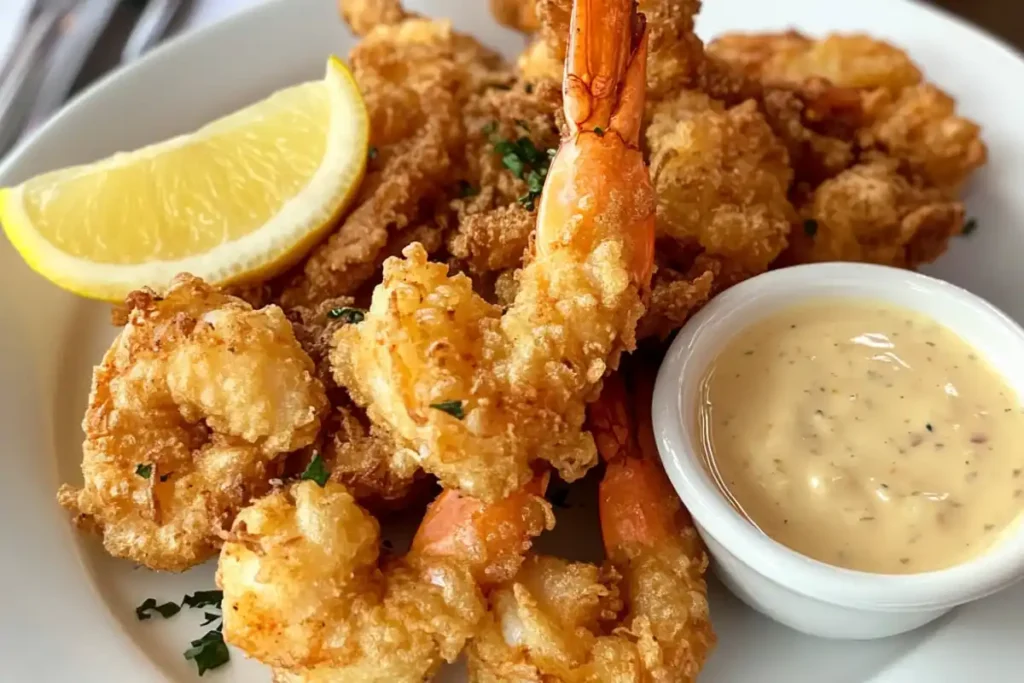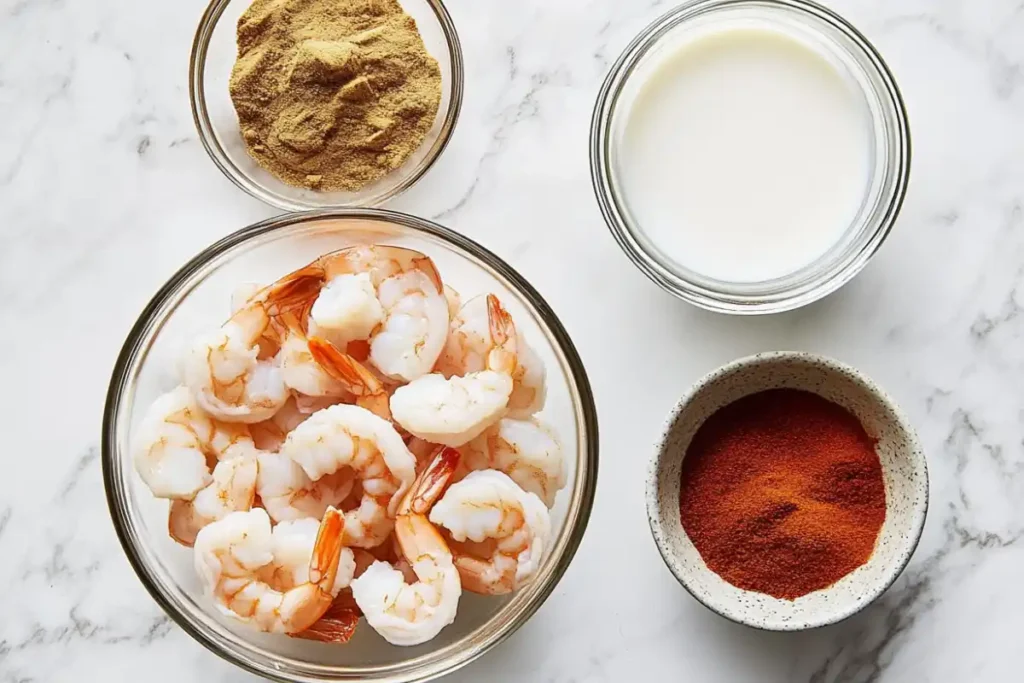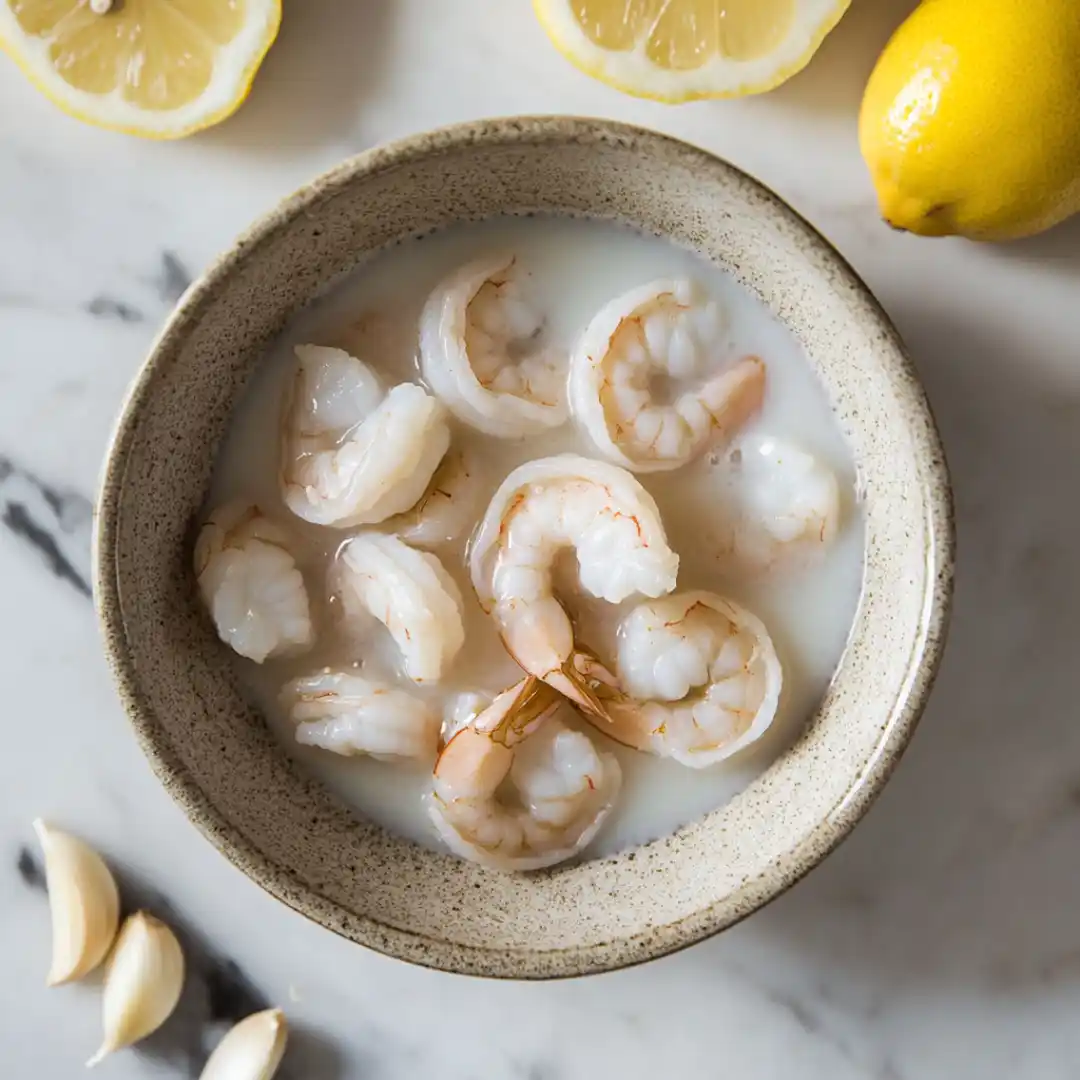Fried shrimp, crispy on the outside, tender and juicy on the inside, is a comfort food classic that shows up in everything from backyard cookouts to upscale restaurant menus. But here’s the kicker: have you ever heard of soaking shrimp in milk before tossing it into hot oil? Sounds odd, right? Yet, it’s a popular prep method in kitchens across the U.S., especially in Southern cooking.
In this article, we’re diving deep into the answer to why do you soak shrimp in milk before frying? Spoiler alert: it’s not just about flavor. We’ll cover the science behind it, what milk actually does to the shrimp, how it impacts texture and taste, and whether it’s really necessary. We’ll also compare it to other methods, debunk a few myths, and toss in some pro tips and FAQs for good measure. So grab your apron, let’s fry this topic wide open!
Introduction to the Practice
What Does It Mean to Soak Shrimp in Milk?
When a recipe tells you to soak shrimp in milk, it’s not suggesting you make a seafood smoothie. It’s a pre cooking step where raw, peeled shrimp are submerged in a bowl of plain milk (or sometimes buttermilk) for a short time before breading and frying. This seemingly simple process can make a big difference in how your shrimp tastes and feels after it’s cooked.
The milk soak isn’t just about adding moisture, it’s about neutralizing strong seafood odors, improving texture, and prepping the surface of the shrimp for that golden, crispy finish. Milk and seafood might not sound like best friends, but in this case, they really are.
Brief History and Popularity in Cooking Techniques
Soaking shrimp—or any seafood, in milk has its roots in traditional Southern cuisine, where buttermilk was often used to mellow out “fishy” flavors in catfish or shrimp before frying. Over time, this practice spread and evolved, making its way into home kitchens and professional menus alike.
Why is it still popular today? Because it works. From helping remove fishy smell from shrimp to tenderizing the meat, this trick has stood the test of time. And honestly, once you try it, it might just become your go to move before frying up your next shrimp batch.
The Science Behind Milk Soaking
Neutralizing Odors: How Milk Affects Shrimp’s Smell
Ever opened a bag of shrimp and instantly caught that strong ocean funk? Yeah, we’ve all been there. One of the top reasons people ask, why do you soak shrimp in milk before frying?, is because milk helps tone down that fishy odor. The key here? A little protein in milk called casein.
Casein binds to trimethylamine, a compound in seafood that’s responsible for that unpleasant smell. When you soak shrimp in milk, it neutralizes the odor causing compounds, making the shrimp smell fresher and more appetizing. This is especially useful if you’re working with frozen or farm-raised shrimp, which often carry stronger scents than wild caught varieties.
So yes, it’s not just a Southern grandma’s trick, it’s basic food chemistry at work!
The Role of Casein and Lactic Acid in Milk
Now, let’s break it down a bit more. Milk isn’t just a scent buster; it’s also a mild marinade. Lactic acid in milk gently tenderizes shrimp by loosening up the muscle fibers without breaking them down too much. This keeps your shrimp from turning rubbery after hitting the fryer.
Casein, on the other hand, doesn’t just deal with smell, it also pulls out any lingering iodine or muddy flavors that shrimp might carry. This can be a game changer, especially if you want your breading or batter to really shine without interference from unwanted seafood funk.
In other words, the milk soak is doing double duty, cleaning up the shrimp’s flavor and making sure your final fry tastes clean and crisp. When it comes to prepping shrimp, this step just might be your secret weapon.
Flavor and Texture Enhancements

How Milk Tenderizes Shrimp for Frying
Let’s talk texture. If you’re dreaming of that crisp-on-the-outside, tender-on-the-inside bite, soaking shrimp in milk could be your golden ticket. Thanks to milk’s gentle acids, it softens the outer layer of the shrimp just enough to ensure a juicy interior without overcooking.
Unlike lemon juice or vinegar, which can “cook” the shrimp if left too long, milk is much milder. That means you get all the tenderizing benefits without the risk of turning your shrimp mushy. And the result? A firm, plump bite that practically begs for a crunchy breading.
Not to mention, if you’re using a seasoned coating, the milk soak helps the flour or batter stick better, ensuring an even fry all over.
Flavor Absorption and Mellowing Harsh Notes
Let’s face it, shrimp is delicious, but it can carry some strong oceanic undertones. Milk helps balance that out. It mellows harsh notes, especially in frozen or slightly older shrimp, making the flavor cleaner and more buttery when cooked.
Because milk is mildly sweet and creamy, it complements the natural flavor of shrimp rather than overpowering it. This is why many home cooks and chefs swear by soaking shrimp before tossing them in the fryer. It acts like a flavor primer, subtle, but powerful.
And here’s a bonus: if you season your milk with a pinch of salt or a dash of garlic powder, it can infuse your shrimp with extra taste right from the start. Just another reason to make soaking shrimp in milk part of your go to prep routine.
Comparing Milk With Other Soaking Liquids
Milk vs. Buttermilk, Lemon Juice, and Saltwater
Sure, soaking shrimp in milk sounds like a solid move, but how does it stack up against other soaking options? Let’s break it down.
First up, buttermilk. It’s often used in Southern style recipes and offers a more acidic punch than regular milk. This can help break down tougher proteins faster, but it also comes with a stronger tang that not everyone wants. Plus, if overused, it can overpower shrimp’s natural sweetness.
Lemon juice is another go-to for many cooks, especially for raw shrimp in ceviche. But here’s the catch: lemon juice is way more acidic than milk, and it can start to “cook” the shrimp if you leave it too long, giving it a mushy texture before it ever hits the fryer.
Then there’s the classic saltwater brine. This method is excellent for boosting moisture and helping shrimp retain their juiciness when cooked. However, it doesn’t help much with mellowing odors or softening texture the way milk does.
So, why do you soak shrimp in milk before frying instead of these alternatives? Because milk offers the best of both worlds, it’s gentle, neutralizes odor, and keeps shrimp moist and mild without changing its flavor profile.
Choosing the Right Soak Based on Frying Style
If you’re frying shrimp with a thick batter or breadcrumbs, milk is your best friend. It adds just enough moisture to help coatings stick without making them soggy. On the other hand, if you’re doing a quick pan fry or sauté, a light saltwater soak might be enough.
Still, for most deep fried dishes, especially Southern style or crispy shrimp recipes, milk soaking delivers ideal texture, flavor, and aroma. It’s an easy step that can seriously elevate your cooking game.
Step by Step: How to Soak Shrimp in Milk
Ingredients and Proportions
So you’re ready to try it, great choice! Prepping shrimp with milk is simple and fuss free. Here’s what you’ll need:
- 1 pound of raw, peeled shrimp
- 1 cup of whole milk (or buttermilk for a tangier flavor)
- Optional: ½ teaspoon of salt or garlic powder for extra taste
Place your cleaned shrimp in a bowl and pour the milk over them until fully covered. Give them a quick stir so every piece gets a nice bath. If you’re adding seasonings, mix those in too. Then just pop the bowl in the fridge.
Duration and Preparation Tips
So, how long do you soak shrimp in milk before frying? About 20 to 30 minutes is perfect. You don’t need much more than that. The milk does its job pretty quickly, breaking down odors and gently tenderizing without “cooking” the shrimp like acidic marinades would.
After soaking, drain the shrimp and pat them dry with paper towels. This step’s key, too much milk left on the shrimp will mess with your breading or batter.
And just like that, you’re prepped and ready to fry!

Does It Affect the Frying Process?
Impact on Coating Adherence (Breading or Batter)
One of the biggest wins of soaking shrimp in milk is how it preps the surface of the shrimp for a perfect fry. Ever had breading slide off your shrimp mid-cook? Frustrating, right? Well, milk helps fix that.
The slight moisture milk leaves behind helps flour, breadcrumbs, or seasoned batter cling to the shrimp like a dream. It creates a sticky surface that’s not too wet, not too dry, just right for frying. This leads to a more even, golden crust that doesn’t fall apart when flipped.
That’s another reason why you soak shrimp in milk before frying. It’s not just about flavor or smell, it’s also about getting that crispy outer layer that holds up from skillet to plate.
Does Milk-Soaked Shrimp Fry Differently?
Yes, it really does. Shrimp that’s been soaked in milk tends to cook more evenly. The milk pre-treatment helps lock in moisture, so the shrimp stays tender on the inside while the outside crisps up beautifully.
More importantly, the subtle dairy notes in milk can lightly mellow the taste, creating a richer, deeper flavor once fried. You’re not just getting crunch, you’re getting character. So next time you’re heating oil, give milk soaked shrimp a go. It could be your secret to the best fried shrimp yet.
Myths vs. Facts About Soaking Shrimp in Milk
Is It a Southern Tradition or Just Science?
You might’ve heard someone say, “It’s how grandma did it,” and that’s partially true. Soaking shrimp, or any seafood, in milk is deeply rooted in Southern cooking, especially where frying reigns supreme. But it’s not just tradition talking, it’s also backed by food science.
Many folks believe milk soaking is only about reducing fishy smell, but in reality, it does much more. Milk helps clean, tenderize, and prep the shrimp for frying. That’s why asking why do you soak shrimp in milk before frying? leads you to both Southern kitchens and culinary labs.
It’s not a myth, it’s a time tested method that just happens to also be backed by chemistry.
Separating Culinary Fact from Folklore
Some believe milk soaking is overhyped, or worse, unnecessary. But when you compare shrimp soaked in milk to those that go straight into the fryer, the difference is clear. The milk-soaked shrimp smell fresher, taste cleaner, and have better texture.
It’s easy to dismiss these steps as old school, but if you skip the milk soak, you might also be skipping out on peak flavor and texture. So while tradition started the trend, science explains why it stuck around.
Truth is, soaking shrimp in milk before frying isn’t just an old trick, it’s a smart one.
Health & Safety Considerations
Is It Safe to Soak Seafood in Milk?
A common concern folks have is whether soaking shrimp in milk is safe. The short answer? Yes, it is, if done right. Since both milk and seafood are perishable, you need to keep everything cold. Soak shrimp in milk in the fridge, not at room temperature, and don’t let it sit longer than 30 minutes.
Milk’s natural enzymes work best cold, and keeping it chilled also prevents bacterial growth. So, when asking why do you soak shrimp in milk before frying?, safety isn’t a drawback—it just needs a little care.
Lactose Intolerance & Dairy Free Alternatives
Got lactose issues? Don’t worry. While whole milk is commonly used, you can try lactose-free milk or mild dairy alternatives like unsweetened oat or soy milk. They may not neutralize odors as well as real milk, but they still help with tenderizing and moisture retention.
So, whether you’re dairy free or not, there are still ways to prep shrimp smartly before frying.
Chef Tips and Variations
How Chefs Use Milk-Soaking in Professional Kitchens
In professional kitchens, time is money, but that doesn’t stop chefs from soaking shrimp in milk. Why? Because it works. A quick milk soak helps chefs deliver consistently tender, mild-flavored shrimp that don’t overpower a dish. Plus, it’s a simple prep step that ensures crispy coatings and juicy results every time.
Some even infuse the milk with aromatics, think garlic, paprika, or herbs, to give the shrimp an added layer of flavor before it ever touches a pan.
Regional and Cultural Differences in Preparation
Though popular in the South, the milk soak isn’t just a one-region trick. In coastal areas and across food cultures, cooks have adapted the idea in different ways. In some Asian cuisines, for instance, coconut milk may be used to marinate seafood, offering a tropical twist while still cutting through odors.
So, why do you soak shrimp in milk before frying? Well, it’s a versatile, cross cultural trick that elevates your shrimp, no matter where you’re cooking from.
FAQs
Can I use milk to remove the fishy taste from shrimp?
Absolutely! This is actually one of the main reasons why you soak shrimp in milk before frying. Milk, especially whole milk, contains casein, which binds to the compounds that cause strong fishy odors and neutralizes them. So, soaking helps tame the smell and flavor.
How long should I soak shrimp in milk before frying?
You only need about 20 to 30 minutes. Soaking longer isn’t necessary and could soften the shrimp too much. Just pop them in the fridge during the soak to keep things safe and fresh.
Does soaking shrimp in milk make them more tender?
Yes, it does. The lactic acid in milk gently breaks down proteins, resulting in a firmer but still tender bite. It’s one of the reasons this method is loved by home cooks and chefs alike.
Is soaking seafood in milk a Southern tradition?
You bet. This trick has Southern roots and is especially common in fried catfish and shrimp dishes. But today, it’s used well beyond the South because, well, it works wonders.
Conclusion and Final Thoughts
So, why do you soak shrimp in milk before frying? The answer is simple: it enhances every aspect of the dish. From neutralizing odor to tenderizing texture and boosting coating adherence, a quick milk soak takes your shrimp from average to unforgettable.
It’s a small step, but it packs a flavorful punch, and helps ensure every bite is fresh, juicy, and perfectly fried. Whether you’re cooking for guests or just upgrading dinner at home, this simple prep trick is worth adding to your kitchen toolkit.
So next time shrimp’s on the menu, pour some milk and let the magic begin.
